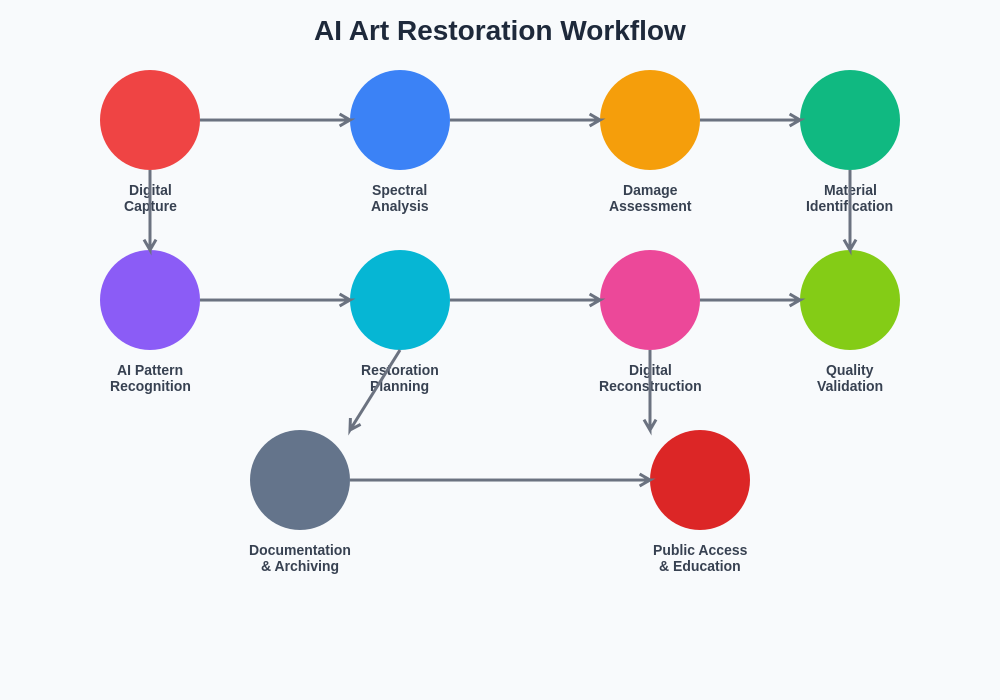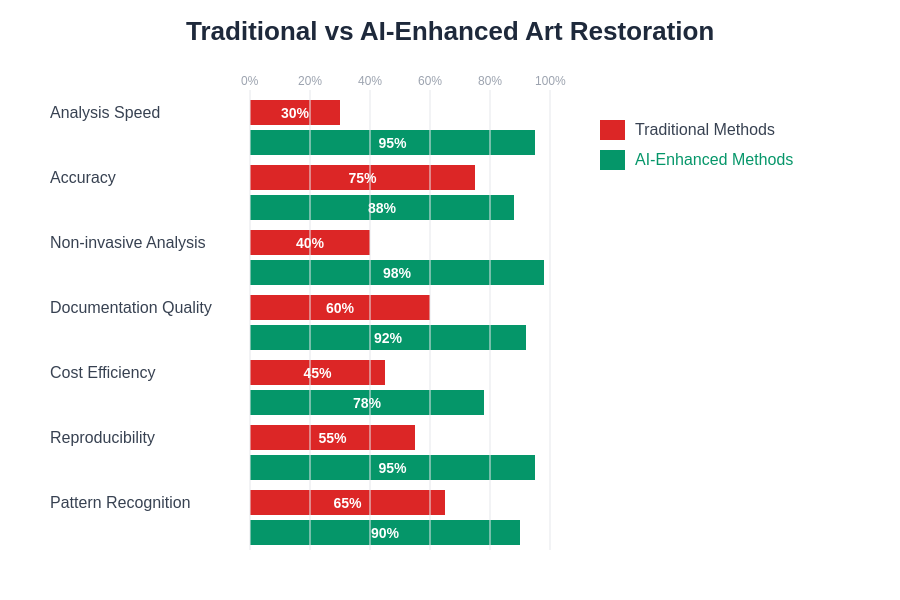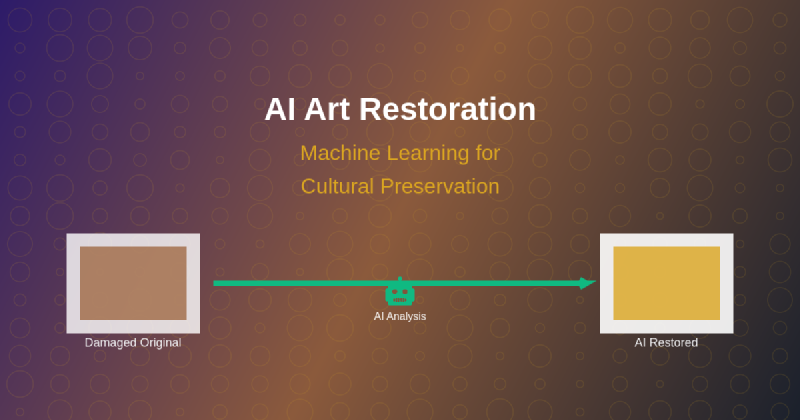The intersection of artificial intelligence and cultural preservation represents one of the most profound applications of modern technology in safeguarding humanity’s artistic legacy. As countless masterpieces face the relentless march of time, environmental degradation, and human conflict, machine learning has emerged as a revolutionary force in art restoration, offering unprecedented capabilities to analyze, understand, and digitally restore cultural artifacts with precision that was previously unimaginable.
Explore the latest AI developments in creative applications to understand how artificial intelligence continues to transform traditional fields and preserve our collective cultural memory. The convergence of computational power, advanced algorithms, and deep learning techniques has opened entirely new possibilities for art conservators, historians, and cultural institutions worldwide, enabling them to approach restoration challenges with tools that complement and enhance traditional conservation methods.
The Evolution of Art Restoration Through Technology
Traditional art restoration has long been considered both an art and a science, requiring decades of expertise, meticulous attention to detail, and an intimate understanding of artistic techniques, materials, and historical contexts. The introduction of machine learning into this field represents a paradigm shift that amplifies human expertise rather than replacing it, providing conservators with powerful analytical tools that can detect patterns, identify materials, and predict deterioration processes at scales and speeds impossible through manual examination alone.
The transformation brought about by AI-powered restoration tools extends far beyond simple image enhancement or color correction. Modern machine learning systems can analyze microscopic details of paint layers, identify original pigments beneath centuries of accumulated grime, reconstruct missing portions of artworks based on stylistic analysis, and even predict future conservation needs through predictive modeling of environmental factors and material properties.
This technological evolution has democratized access to advanced restoration techniques, enabling smaller museums and cultural institutions to benefit from sophisticated analytical capabilities that were previously available only to major museums with substantial resources. The result is a more comprehensive and collaborative approach to cultural preservation that transcends geographical and economic boundaries.
Machine Learning Techniques in Digital Restoration
The application of machine learning to art restoration encompasses a diverse array of computational approaches, each designed to address specific challenges in cultural preservation. Convolutional neural networks have proven particularly effective in image inpainting tasks, where missing or damaged portions of artworks must be reconstructed based on surrounding visual information and learned artistic patterns from extensive training datasets.
Generative adversarial networks represent another breakthrough technology in digital restoration, capable of producing highly realistic reconstructions of damaged artwork by learning to distinguish between authentic artistic elements and restoration artifacts. These systems can generate multiple restoration hypotheses, allowing conservators to evaluate different approaches and select the most historically and artistically appropriate solutions for each unique restoration challenge.
Computer vision algorithms have revolutionized the analysis of artistic techniques, enabling researchers to identify brushstroke patterns, paint application methods, and stylistic characteristics that can inform both restoration decisions and attribution studies. These capabilities extend to the detection of underlying sketches, previous restoration attempts, and hidden compositional elements that may not be visible to the naked eye or traditional analytical methods.
Experience advanced AI capabilities with Claude for comprehensive analysis and research support in complex cultural preservation projects. The integration of multiple AI technologies creates a synergistic effect where different machine learning approaches complement each other to provide holistic solutions for restoration challenges.
Spectral Analysis and Material Identification
One of the most significant contributions of machine learning to art restoration lies in its ability to analyze spectral data from various imaging techniques, including X-radiography, infrared reflectography, and multispectral imaging. Machine learning algorithms can process these complex datasets to identify pigments, binding media, and support materials with unprecedented accuracy, providing conservators with detailed information about the original artist’s materials and techniques.
The identification of historical pigments through AI analysis has proven invaluable for understanding artistic practices across different periods and geographical regions. Machine learning systems trained on extensive databases of pigment signatures can distinguish between original materials and later additions, helping conservators make informed decisions about which elements of an artwork represent the artist’s original intent and which may be the result of previous restoration attempts or natural aging processes.
Advanced spectral analysis through machine learning has also enabled the detection of underlying compositions and pentimenti, providing insights into the creative process and artistic development that were previously accessible only through destructive sampling or invasive analysis techniques. This non-invasive approach to material analysis has revolutionized art historical research and conservation planning.
Damage Assessment and Conservation Planning
Machine learning algorithms excel at pattern recognition and anomaly detection, making them ideal tools for comprehensive damage assessment in cultural artifacts. These systems can analyze high-resolution images to identify various forms of deterioration, including paint loss, cracking, discoloration, and structural damage, creating detailed condition reports that inform conservation priorities and treatment strategies.
The ability of AI systems to quantify and categorize different types of damage provides conservators with objective data for developing preservation strategies and monitoring the effectiveness of conservation treatments over time. Machine learning models can track changes in artwork condition through comparative analysis of images taken at different intervals, enabling proactive conservation interventions before minor issues develop into major problems.
Predictive modeling based on environmental data, material properties, and historical deterioration patterns allows cultural institutions to develop long-term preservation strategies that optimize resource allocation and prioritize conservation efforts based on scientific analysis rather than subjective assessments. This data-driven approach to conservation planning has improved the efficiency and effectiveness of preservation programs worldwide.

The systematic application of machine learning in art restoration follows a comprehensive workflow that integrates multiple analytical techniques with human expertise. This process ensures that technological capabilities are applied appropriately while maintaining the highest standards of scholarly rigor and ethical conservation practice.
Virtual Reconstruction and Digital Twins
The concept of digital twins has found profound application in cultural preservation, where machine learning algorithms create comprehensive digital replicas of artworks that serve multiple purposes in conservation, research, and public engagement. These virtual reconstructions go beyond simple photographic documentation to include detailed analysis of materials, techniques, and condition states that can be manipulated and studied without risk to the original artifacts.
Machine learning-powered virtual reconstruction has enabled the restoration of artworks that exist only in fragments or have been lost entirely, using stylistic analysis and historical documentation to create scientifically informed reconstructions that advance scholarly understanding of artistic traditions and individual artists’ bodies of work. These digital reconstructions serve as valuable research tools and educational resources while preserving the integrity of original artifacts.
The development of interactive digital environments where users can explore artworks in unprecedented detail has transformed museum experiences and educational opportunities. Machine learning algorithms can guide virtual tours, highlight significant details, and provide contextual information based on user interests and expertise levels, creating personalized engagement experiences that enhance public appreciation of cultural heritage.
Collaborative Platforms and Data Sharing
Machine learning has facilitated the development of collaborative platforms where conservators, researchers, and cultural institutions can share data, expertise, and analytical results to advance collective understanding of art restoration challenges. These platforms leverage distributed computing power and collective intelligence to tackle complex restoration projects that would be impossible for individual institutions to address independently.
The standardization of data formats and analytical protocols through machine learning frameworks has improved the reproducibility and reliability of restoration research, enabling more rigorous scientific approaches to conservation decision-making. Shared databases of spectral signatures, pigment analyses, and restoration case studies provide valuable resources for the global conservation community.
Access comprehensive research capabilities with Perplexity to support interdisciplinary collaboration in cultural preservation projects that require integration of diverse knowledge domains and analytical approaches. The democratization of advanced analytical tools through collaborative platforms has leveled the playing field for smaller institutions and emerging conservation programs.
Ethical Considerations in AI-Powered Restoration
The application of machine learning to art restoration raises important ethical questions about authenticity, interpretation, and the boundaries of appropriate intervention in cultural artifacts. The development of clear guidelines and professional standards for AI-assisted restoration ensures that technological capabilities are applied in ways that respect the integrity of original artworks and the intentions of their creators.
The question of how much digital intervention is appropriate in art restoration requires careful consideration of scholarly consensus, cultural sensitivities, and the intended use of restored artworks. Machine learning systems must be designed and applied in ways that maintain transparency about restoration processes and preserve the ability to distinguish between original artistic elements and reconstructed portions.
The documentation of AI-assisted restoration processes has become increasingly important for maintaining scholarly integrity and enabling future researchers to understand and evaluate restoration decisions. Comprehensive metadata and process documentation ensure that the application of machine learning techniques contributes to rather than obscures the historical record of cultural artifacts.
Training Data and Bias Mitigation
The effectiveness of machine learning systems in art restoration depends heavily on the quality and diversity of training data used to develop these systems. Ensuring representative datasets that include diverse artistic traditions, cultural contexts, and conservation challenges is essential for developing AI tools that can serve global cultural preservation needs without perpetuating historical biases or cultural blind spots.
The development of inclusive training datasets requires collaboration between technologists and cultural experts from diverse backgrounds to ensure that machine learning systems can effectively analyze and restore artworks from all cultural traditions. This collaborative approach helps prevent the inadvertent marginalization of non-Western artistic traditions or minority cultural expressions in AI-powered restoration tools.
Ongoing evaluation and refinement of machine learning models helps identify and correct biases that may emerge during system development or deployment. Regular assessment of system performance across different artistic styles, cultural contexts, and conservation challenges ensures that AI tools remain effective and equitable as they are applied to increasingly diverse preservation projects.

The comparison between traditional restoration methods and AI-enhanced approaches reveals significant improvements in accuracy, efficiency, and documentation quality while maintaining the essential human elements of interpretation, aesthetic judgment, and cultural sensitivity that define professional conservation practice.
Case Studies in Successful AI Restoration Projects
The application of machine learning to major restoration projects has produced remarkable results that demonstrate the transformative potential of AI in cultural preservation. The digital restoration of war-damaged frescoes has enabled virtual reconstruction of destroyed cultural sites, providing valuable resources for historical research and cultural memory preservation even when physical reconstruction is impossible.
Machine learning analysis of palimpsests and overwritten manuscripts has revealed hidden texts and previously unknown works by historical authors, expanding our understanding of literary and philosophical traditions. These discoveries highlight the potential for AI tools to uncover new knowledge and insights that were previously inaccessible through traditional analytical methods.
The restoration of faded or damaged photographs and historical documents through machine learning has preserved important historical records and made them accessible to new generations of researchers and the general public. These projects demonstrate the broad applicability of AI restoration techniques beyond traditional fine art conservation.
Future Developments and Emerging Technologies
The continued advancement of machine learning capabilities promises even more sophisticated applications in art restoration and cultural preservation. Emerging technologies such as quantum computing and advanced neural network architectures may enable analysis and reconstruction capabilities that are currently beyond the reach of existing systems.
The integration of virtual and augmented reality technologies with machine learning-powered restoration tools is creating new possibilities for immersive cultural experiences and educational applications. These developments may transform how the public interacts with cultural heritage and how conservators approach complex restoration challenges.
The development of specialized hardware and software platforms designed specifically for cultural preservation applications is making advanced AI tools more accessible to conservation professionals while reducing the technical barriers that may have limited adoption of these technologies in the cultural heritage sector.
Impact on Museum Operations and Public Engagement
Machine learning-powered restoration and analysis tools have transformed museum operations by enabling more efficient collection management, condition monitoring, and conservation planning. These capabilities allow cultural institutions to make more informed decisions about exhibition schedules, loan agreements, and long-term preservation strategies.
The ability to create high-quality digital reproductions and virtual exhibitions through AI-enhanced imaging and reconstruction techniques has expanded public access to cultural heritage while reducing physical stress on fragile artifacts. These digital resources enable global audiences to engage with cultural treasures that may be geographically or physically inaccessible.
Educational applications of AI restoration technology have created new opportunities for teaching art history, conservation science, and cultural studies through interactive digital platforms that allow students to explore artworks and conservation processes in unprecedented detail. These tools enhance learning experiences while fostering appreciation for cultural preservation efforts.
Challenges and Limitations
Despite the remarkable capabilities of machine learning in art restoration, significant challenges remain in areas such as computational complexity, data requirements, and the need for specialized expertise to implement and interpret AI-powered analytical results. Addressing these challenges requires continued collaboration between technologists, conservators, and cultural institutions.
The high computational requirements of advanced machine learning systems can create barriers to adoption for smaller institutions with limited technical resources. Developing more efficient algorithms and cloud-based solutions helps democratize access to AI restoration tools while maintaining the sophistication needed for complex conservation challenges.
The interpretation of machine learning results requires specialized expertise that combines technical understanding of AI systems with deep knowledge of art history, conservation science, and cultural contexts. Training programs and professional development opportunities help build this interdisciplinary expertise within the conservation community.
Global Collaboration and Cultural Exchange
The application of machine learning to cultural preservation has fostered unprecedented international collaboration between museums, universities, technology companies, and cultural organizations. These partnerships have accelerated the development and deployment of AI tools while ensuring that diverse cultural perspectives inform technological development.
Digital preservation initiatives powered by machine learning have created opportunities for cultural exchange and mutual support between institutions worldwide. Shared resources, expertise, and technology platforms enable collaborative approaches to preservation challenges that transcend national boundaries and institutional limitations.
The documentation and preservation of endangered cultural traditions through AI-powered recording and analysis techniques helps maintain cultural diversity and provides resources for cultural revitalization efforts. These applications demonstrate the potential for technology to support cultural continuity and identity preservation in an increasingly globalized world.
The future of AI-powered art restoration lies in continued collaboration between human expertise and machine intelligence, creating synergistic relationships that enhance rather than replace traditional conservation approaches. This partnership between technology and human knowledge promises to preserve our cultural heritage for future generations while advancing our understanding of artistic traditions and creative expression throughout human history.
Disclaimer
This article is for informational purposes only and does not constitute professional conservation advice. The views expressed are based on current understanding of AI technologies and their applications in cultural preservation. Readers should conduct their own research and consult with qualified conservation professionals when implementing AI-powered restoration techniques. The effectiveness and appropriateness of AI assistance may vary depending on specific artworks, conservation challenges, and institutional requirements.
